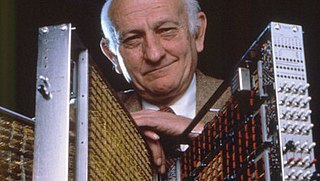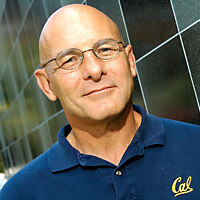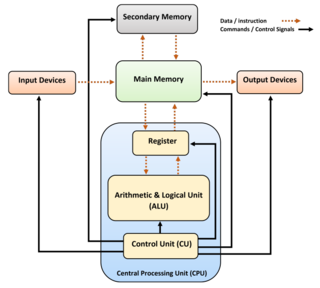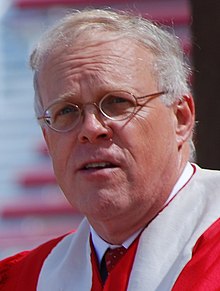
Leslie B. Lamport is an American computer scientist and mathematician. Lamport is best known for his seminal work in distributed systems, and as the initial developer of the document preparation system LaTeX and the author of its first manual.

John Cocke was an American computer scientist recognized for his large contribution to computer architecture and optimizing compiler design. He is considered by many to be "the father of RISC architecture."

Stephen Byram Furber is a British computer scientist, mathematician and hardware engineer, and Emeritus ICL Professor of Computer Engineering in the Department of Computer Science at the University of Manchester, UK. After completing his education at the University of Cambridge, he spent the 1980s at Acorn Computers, where he was a principal designer of the BBC Micro and the ARM 32-bit RISC microprocessor. As of 2023, over 250 billion ARM chips have been manufactured, powering much of the world's mobile computing and embedded systems, everything from sensors to smartphones to servers.

David Andrew Patterson is an American computer pioneer and academic who has held the position of professor of computer science at the University of California, Berkeley since 1976. He announced retirement in 2016 after serving nearly forty years, becoming a distinguished software engineer at Google. He currently is vice chair of the board of directors of the RISC-V Foundation, and the Pardee Professor of Computer Science, Emeritus at UC Berkeley.
MIPS, an acronym for Microprocessor without Interlocked Pipeline Stages, was a research project conducted by John L. Hennessy at Stanford University between 1981 and 1984. MIPS investigated a type of instruction set architecture (ISA) now called reduced instruction set computer (RISC), its implementation as a microprocessor with very large scale integration (VLSI) semiconductor technology, and the effective exploitation of RISC architectures with optimizing compilers. MIPS, together with the IBM 801 and Berkeley RISC, were the three research projects that pioneered and popularized RISC technology in the mid-1980s. In recognition of the impact MIPS made on computing, Hennessey was awarded the IEEE John von Neumann Medal in 2000 by the Institute of Electrical and Electronics Engineers (IEEE), the Eckert–Mauchly Award in 2001 by the Association for Computing Machinery, the Seymour Cray Computer Engineering Award in 2001 by the IEEE Computer Society, and, again with David Patterson, the Turing Award in 2017 by the ACM.
The International Symposium on Computer Architecture (ISCA) is an annual academic conference on computer architecture, generally viewed as the top-tier in the field. Association for Computing Machinery's Special Interest Group on Computer Architecture and Institute of Electrical and Electronics Engineers Computer Society are technical sponsors.

Mark A. Horowitz is an American electrical engineer, computer scientist, inventor, and entrepreneur who is the Yahoo! Founders Professor in the School of Engineering and the Fortinet Founders Chair of the Department of Electrical Engineering at Stanford University. He holds a joint appointment in the Electrical Engineering and Computer Science departments and previously served as the Chair of the Electrical Engineering department from 2008 to 2012. He is a co-founder, the former chairman, and the former chief scientist of Rambus Inc.. Horowitz has authored over 700 published conference and research papers and is among the most highly-cited computer architects of all time. He is a prolific inventor and holds 374 patents as of 2023.

In computer science and computer engineering, computer architecture is a description of the structure of a computer system made from component parts. It can sometimes be a high-level description that ignores details of the implementation. At a more detailed level, the description may include the instruction set architecture design, microarchitecture design, logic design, and implementation.

Oyekunle Ayinde "Kunle" Olukotun is a British-born Nigerian computer scientist who is the Cadence Design Systems Professor of the Stanford School of Engineering, Professor of Electrical Engineering and Computer Science at Stanford University and the director of the Stanford Pervasive Parallelism Lab. Olukotun is known as the “father of the multi-core processor”, and the leader of the Stanford Hydra Chip Multiprocessor research project. Olukotun's achievements include designing the first general-purpose multi-core CPU, innovating single-chip multiprocessor and multi-threaded processor design, and pioneering multicore CPUs and GPUs, transactional memory technology and domain-specific languages programming models. Olukotun's research interests include computer architecture, parallel programming environments and scalable parallel systems, domain specific languages and high-level compilers.
Susan J. Eggers is an American computer scientist noted for her research on computer architecture and compilers.
Stanford DASH was a cache coherent multiprocessor developed in the late 1980s by a group led by Anoop Gupta, John L. Hennessy, Mark Horowitz, and Monica S. Lam at Stanford University. It was based on adding a pair of directory boards designed at Stanford to up to 16 SGI IRIS 4D Power Series machines and then cabling the systems in a mesh topology using a Stanford-modified version of the Torus Routing Chip. The boards designed at Stanford implemented a directory-based cache coherence protocol allowing Stanford DASH to support distributed shared memory for up to 64 processors. Stanford DASH was also notable for both supporting and helping to formalize weak memory consistency models, including release consistency. Because Stanford DASH was the first operational machine to include scalable cache coherence, it influenced subsequent computer science research as well as the commercially available SGI Origin 2000. Stanford DASH is included in the 25th anniversary retrospective of selected papers from the International Symposium on Computer Architecture and several computer science books, has been simulated by the University of Edinburgh, and is used as a case study in contemporary computer science classes.
Christos (Christoforos) Kozyrakis is a professor of Electrical Engineering and Computer Science at Stanford University, where he leads the multi-scale architecture & systems team (MAST). His current research interests are on resource efficient cloud computing, energy efficient compute and memory systems, and architectural support for security. Kozyrakis was the 2015 ACM Maurice Wilkes Award for outstanding contributions to transactional memory systems.
Daniel P. Siewiorek is an American computer engineer and computer scientist, currently the Buhl University Professor Emeritus of Electrical and Computer Engineering and Computer Science at Carnegie Mellon University.

ACM SIGARCH is the Association for Computing Machinery's Special Interest Group on computer architecture, a community of computer professionals and students from academia and industry involved in research and professional practice related to computer architecture and design. The organization sponsors many prestigious international conferences in this area, including the International Symposium on Computer Architecture (ISCA), recognized as the top conference in this area since 1975. Together with IEEE Computer Society's Technical Committee on Computer Architecture (TCCA), it is one of the two main professional organizations for people working in computer architecture.
The Association for Computing Machinery SIGARCH Maurice Wilkes Award is given annually for outstanding contribution to computer architecture by a young computer scientist or engineer; "young" defined as having a career that started within the last 20 years. The award is named after Maurice Wilkes, a computer scientist credited with several important developments in computing such as microprogramming. The award is presented at the International Symposium on Computer Architecture. Prior recipients include:
Mark D. Hill is a computer scientist and professor at the University of Wisconsin–Madison. He has been cited over 27,000 times.
Norman Paul Jouppi is an American electrical engineer and computer scientist.
Timothy M. Pinkston is an American computer engineer, researcher, educator and administrator whose work is focused in the area of computer architecture. He holds the George Pfleger Chair in Electrical and Computer Engineering and is a Professor of Electrical and Computer Engineering at University of Southern California (USC). He also serves in an administrative role as Vice Dean for Faculty Affairs at the USC Viterbi School of Engineering.
Luca Benini is a computer scientist who is a Professor of Electronics at University of Bologna and the Chair of Digital Circuits and Systems at ETH Zurich.








